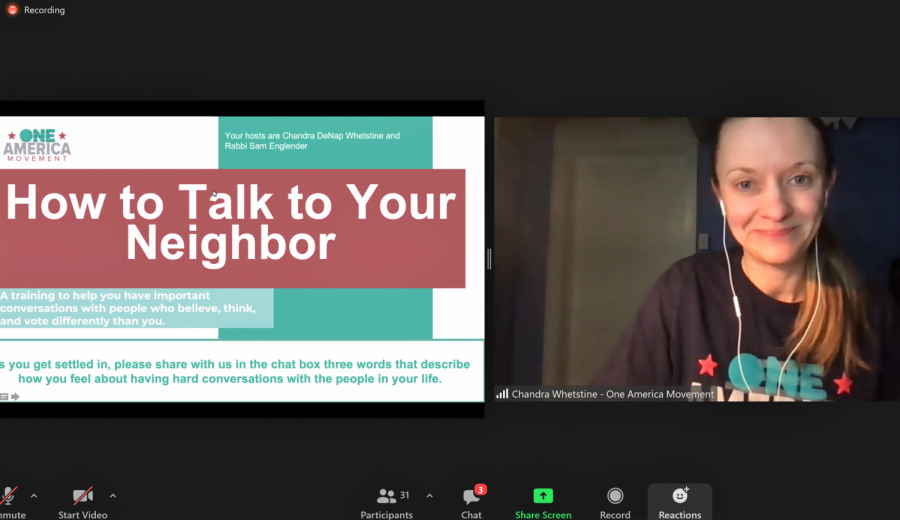GV asks ‘How to talk to your neighbor?’
The Kaufman Interfaith Institute partnered with Calvin College to bring the presentation to students (GVL Katherine Arnold)
Feb 15, 2021
Is it possible to have nuanced, civil conversations about controversial topics? On subjects from COVID-19 restrictions or gun control, many find that talking to those who have opposing beliefs can be stressful and anxiety-inducing. Bridging the divide between people and allowing for open communication is a difficult endeavor to take on, but there’s one group that has dedicated itself wholeheartedly to tackling the issue.
“We are an organization whose mission is to eliminate toxic polarization in the U.S.” said Chandra DeNap Whetstine, the Vice President of Programs and Operations for the One America Movement (OAM). “It is important that we one, build relationships through those important conversations, and two, by doing so, work together on the country’s most pressing problems like homelessness, the opioid crisis, and more. We need everyone so we can tackle these challenges.”
On Feb. 10, Grand Valley State University’s Kaufman Interfaith Institute partnered with Calvin University and OAM to offer a 90-minute training about “How to Talk to Your Neighbor.” Two hosts from OAM led the training: Whetstine and the Michigan Regional Outreach Manager, Rabbi Sam Englender.
“Conversation across difference, and during this political atmosphere are becoming more and more difficult. Why is it so hard to have conversations across difference?” Englender said. “When we think of having those difficult discussions, people will mention being anxious, scared, sweaty, and people are clearly uncomfortable.”
He explained the topic as one stemming from a basic misunderstanding about how we react to a different opinion. A metaphor by Dr. Jonathan Haidt of an elephant and rider is one way of thinking about how our minds work. We have the conscious element, the rider, coupled with the emotional and instinctual elephant. Sometimes it can be all too easy for the elephant to take control and lead us into a heated argument that feels overly personal and insulting.
After the initial talk, Whetstine walked the participants through a guided discussion in paired breakout rooms. Their formula of introductions, open-mindedness and careful listening paved the way for over forty attendees to try out the OAM system of conversation.
It started with each participant choosing a topic to discuss, stating why they are passionate about this issue, what their thoughts about it are, and what they hope the future to be like for that problem. While many felt initial trepidation, other attendees described how much better they felt formally talking through their beliefs. For those who didn’t see eye to eye, it felt like they were able to truly hear someone rather than walk away feeling angry, ashamed, or sad.
“Sometimes we aren’t very self-examined, so going through this process is designed to both self-examine and also hear another person,” Whetstine said. “Why do I believe in what I do? The challenge is facing the emotional ties we have to the issues we need to talk about.”
To learn more about their conversation guide, you can access it at www.oneamericamovement.org/neighbor-guide. Their website contains information about who OAM is, their past work, and their plan for the future.
“These are hard and challenging things,” Whetstine said. “We hope that you will be able to take the conversation guide and use it to have some of the more difficult conversations with people in your life.























